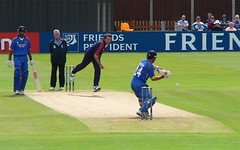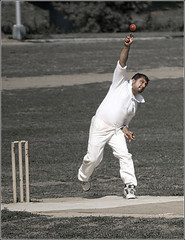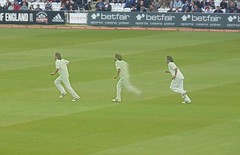How to bowl fast: The 10 immutable Laws of fast bowling

 photo credit: Tc7
photo credit: Tc7
Welcome to miCoach! For more free cricket coaching tips, click here to subscribe to the free miCoach newsletter.
Cricket at every level has never been faster. The influence of Twenty20 cricket now demands batsman who score fast, spinners who turn it miles and, most importantly, bowlers who can blast out the opposition. There are as many different approaches to pace bowling as there are bowlers and coaches. Some ideas are downright misguided but there are a few that remain essential in generating every last ounce of speed from your spell. Here are those bedrock elements:
1. The Law of Universality
Anyone is capable of bowling faster. There is no magic: It's all just a matter of using science to your advantage. The fancy words are biomechanics and physiology but, as we will see, these are just terms for coaching tips that anyone can apply. The main thing to remember while you work through the following Laws is this: Any cricketer can apply them to improve their bowling pace. You just need to put in the commitment to improve.
2. The Law of Professional Application
The chances that you are a professional cricketer while reading this are slim (although you may hope to be). You don't have access to professional coaching. Maybe you don't have access to any coaching. Your valuable free time is split between cricket and other things. Cricket is not your job, it's what you do for fun. Those valid reasons for not being as good as a professional don't stop you from applying a professional attitude during the time you have for cricket. This is what The Law of Professional Application is all about:
- Committing what time you have. We all have some free time. You have a choice what you do with it. If you choose to go to the gym or nets you are applying yourself like a pro. If you choose to watch TV because you are tired you are never going to get faster.
- Thinking 24 hours. You can still apply yourself professionally when you are doing other things. Fast bowling is built on getting the basics right as well as making sure your action is spot on. Getting enough sleep, eating healthy and keeping your stress levels down are often ignored elements of success. If you are too tired or too skinny you are not going to bowl your fastest.
- Crossing the white line. The third element in acting professionally is what you do when you are training (no matter how little free time you have to give to it). Are you working out with direction and intensity? When you hit the nets do you go all out or just turn your arm over? Do you have a goal for every session? There is no reason to have an amateur attitude at these times, even if you are an amateur player.
It's important not to underestimate your mindset when it comes to fast bowling. Really bowling fast starts with your attitude and translates into your body.
3. The Law of the Building From The Ground Up
What separates great fast bowlers from the crowd? Movement. Watching top bowlers like Brett Lee or Michael Holding approach the crease and power through their actions in a smooth, rhythmical way is a critical aspect of top speed. Great movement starts long before the run up and action itself, and no amount of coaching can change that if you have not built your movement skills up first. Physical therapist Gray Cook demonstrates this by talking about a pyramid of performance:
- Skill. This is the peak of the pyramid: The bowling action itself (which we talk about in the next few Laws). If you are lacking the basics of the fast bowling action you need to work with a coach to develop them. Or at the very least, buy and study the coaching chapter in Ian Pont's ground breaking Fast Bowler's Bible.
- Athleticism/Power. Sitting below skill on the pyramid is your general power and athleticism. This is your ability to generate force in a non specific way such as how fast you can run or how high you can jump. Without a decent level of strength you will tire more quickly. You will not have as much capacity in your muscles to produce maximum speed either.
- Mobility/Stability. The base of the pyramid is your ability to perform simple movements with both mobility (able to move through the entire range of the movement) and stability (control the body during movement). If you cannot move freely you cannot bowl as fast as your potential allows. You also have a greater injury risk as your other parts of your body try to compensate for the flaws in your action.


In this next section I'll examine the important skill element: the bowling action itself. Your action is probably the single most important piece in the puzzle of fast bowling. Rightly so, many bowlers focus on it to improve their speed. Here are the Laws that relate directly to your action creating bowling speed.
4. The Law of Arm Speed
Let's start with a simple bit of physics: The faster your bowling arm moves the faster the ball comes out. This is perhaps no revelation. The question is this: How do you get a fast arm?
Your chest is all important. Ensure your chest is as far in front of your hips as possible in your delivery stride. As Ian Pont says, as if the batsman is pulling you towards them with rope tied around your chest. This works because it generates momentum. Like a sprinter coming out of the blocks, the further forward you can lean the more momentum you are able to produce. This converts directly to more arm speed and then more ball speed.
Find a great fast bowler and you will always see a great chest drive.
5. The Law of Powerful Hips
If the chest gets you in the best position of momentum, it's the hips that produce the power. A recent study found a direct relation between jump height and bowling speed. This is because it's the hips that produce the power in both.
How does this feel as you bowl?
Like you are driving your hip forwards. Whether you are side on, front on or halfway between the important element is to have both hips facing the batsman as you deliver the ball. If you have not driven your hip through and it lags behind you literally leak energy and this slows you down. To borrow a phrase from elsewhere, it's like trying to fire a cannon from a canoe.
6. The Law of Long Levers
Here is another simple point of physics: The longer the lever the more acceleration is possible. This is why tall bowlers have a natural advantage as this study proves.
However, the Law still applies to you no matter how long your arms are. Both your bowling and non bowling arms are important levers. This means keeping your arms fully extended as you bowl. Most bowlers do this already with the bowling arm, but it's also vital to use the non bowling arm to drive out and down. This allows you to fully rotate your shoulders and move into the follow through: A giant cartwheel whipping through.
As this study shows, shoulder rotation is directly linked to speed. It's all about using every inch of the levers you have.
7. The Law of Reducing Leaks
What is an energy leak? In bowling performance terms it is a glitch in your movement that is stopping you from bowling at top speed. The body is not made up of individual muscles, it is a chain. In a complex movement like bowling at speed, one small error can cut of the flow of energy through your hips, trunk and shoulder which can significantly slow you down an increase injury risk.
Ian Pont, in The Fast Bowler's Bible, points out that a common energy leak is when a bowler stops his hip driving round by landing his (or her) foot too far to the leg side. This is why it is important to land with an open position at the crease.
Other potential leaks are letting the hip lag behind as you bowl, not using the front foot as a brace, not pushing your front arm out and down and not following through straight towards the batsman. Many of these leaks are technical issues. A good coach or studying The Fast Bowler's Bible could help you stop these kinetic errors.
However, there are more fundamental elements to consider too. Elements that allow you to both get into the best positions easily and generate maximum power from those positions. In the next part we will look at these elements. Most bowlers below the elite level ignore them. Don't make that mistake.

 photo credit: al_green
photo credit: al_green
Many bowlers at club level underestimate how important the final set of Laws are. However, without them you are never going to achieve your potential. If you really want to bowl fast, you must not ignore these Laws. It's not always about technique.
8. The Law of Fast Twitch
At it's most basic, fast bowling is about moving fast. As we know from Law 4, the faster your arm is, the faster the ball will be. A large part of this is technique but underneath that is your very muscle fibres themselves.
As you may already know, our muscles are made up of slow fibres and fast fibres. The fast fibres allow you to produce force quickly. We are all born with different numbers of both but it's possible to increase the number of fast fibres through strength training. The advantages of the right kind of training should be obvious: faster arm speed and more hip drive.
However, you need to train fast to bowl fast. So leave the long, slow jogging and isolation exercises like bicep curls behind. You are looking to perform exercises that increase your ability to generate power in your action. This would be exercises that work your whole body, especially your hips and upper body. For example:
- Jump squat
- Olympic lift variations
- Plyometric push up
- Sprinting
Additionally, other strength training should be performed as fast as you can using proper technique (if you are unsure of the form for an exercise seek advice from a professional fitness training). Most of this strength training will be based on movements rather than muscles: Pushing, pulling, squatting, lunging and twisting. See this book for a complete program that can be done in as little as 2 days a week.
9. The Law of Deliberate Practice
Practice makes perfect they say. In fact, it's perfect practice that makes perfect. How do you practice bowling at pace with a deliberate outcome?
There is nothing more effective than just bowling. You can bring in the help of a coach to work on your technique, but you can go and bowl anytime as long as you have a ball and enough space. Set down a target on a good length and just bowl until you can hit it at will and at pace. England international Jon Lewis recommends you spend 80% of your practice time just aiming to hit a length at maximum pace. The rest of the time is working on variations like yorkers and slower balls.
If you are bowling at a batsman (and most club training sessions will be structured like this) then ignore them and continue to work on hitting your target area even if you can't mark it. Always bowl off your full run up and never bowl no balls.
If you can organise it, bowl in 6 ball overs rather than taking it in turns to bowl and rest for a couple of minutes between overs. This is to make your practice as realistic as possible. However, it's best to avoid this practice if you can.
If your pace is good in nets try and bowl in practice games; either in friendlies or middle practice. This will improve your ability to bowl fast under pressure.
How much you practice depends on your age, time available and goals. The LTAD plan recommends if you are developing skills you should train your skills more than you play (especially if you are under 16). Experienced adult club players who are looking to hone rather than develop need less training time, but 1-2 pre-season and in-season skill sessions of bowling practice per week will show good results.
If you are under 18 you may be subject to your governing body directives on fast bowling. These are designed to prevent over use injuries so I highly recommend you follow the guidelines, even if you 'feel OK'. Many stress fractures are caused by overbowling and since the ECB introduced limits to balls bowled in practice there has been a significant drop in injuries.
10. The Law of Mobility-Stability
A great deal of fast bowling is about technique. However, if you are inflexible or lack strength in your trunk you will be unable to get into the positions of maximum speed potential. You need to be able to combine mobility with stability. In practical terms this means having a good range of motion in your ankles, hips and shoulders. it also means having very stable lower back and knee joints supported by muscles that are able to prevent movement in your legs and abdominal area.
- Range of motion. To be able to drive your chest forward and bring your shoulders round as you drive through, you joints need to give you as much movement as possible. If you are finding these aspects of your action wanting then you should step up the amount of stretching you do. You can do this by increasing your warm up to include more dynamic stretches. You can also do yoga or pilates to teach yourself body awareness and increase your flexibility. Also, if you get injured a lot you may need to do something similar as lack of flexibility increases the risk of injury.
- Prevention of motion. Fast bowling generates a lot of force through the body. This makes the knees and low back potential injury points and the core (deep drunk muscles) a point of energy leak (see Law 7). For this reason you need to include exercises in your strength training that both improve the strength of your deep core and improve your ability to prevent motion (anti-rotation). You can get some ideas here.
A very simple way to test your mobility and stability is to see if you can perform an usupported full depth bodyweight squat without your heels raising off the ground. If you can't do this then more work may be needed. Bear in mind that this is an over-simplified test and if you are worried about this aspect of your bowling it's worth investing in this book. It contains a more full range of tests and some simple exercises you can add to your warm up or cool down to correct the problem.
Finally...
Those are the 10 Laws, none more important than the other and all contributing to your ability to bowl a cricket ball at the maximum speed your genetic potential allows. Some bowlers will be able to reach 90mph. The average club fast bowler is nearer 75mph. Whatever your speed, followling the 10 Laws will help you bowl faster then ever before.
If you enjoyed this post why not subscribe for free to PitchVision miCoach? The site is updated several times a week with free information to help you play better cricket.
- Login to post comments

